News
Can we rely on activity monitors to determine how sedentary participants are?
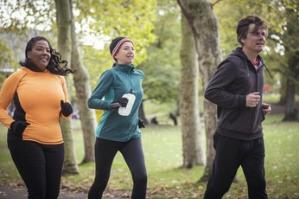
A blog by Susan Hillman
The Muscle Ageing Sarcopenia Study Lifecourse (MASS Lifecourse), began recruiting participants in 2018 with the aim of understanding more about how our muscles change as we get older. With the completion of the baseline assessment of all 260 participants in September 2024, we now have a rich resource of information on people from the North East of England, aged 18 to 85 years. During the baseline assessments we collected data on a wealth of factors relevant to the study of muscle ageing, including health behaviours, physical performance, biological samples and activity levels.
One of the ways we assess how active people are is to ask them; but the other method employed is to ask our participants to wear a research-grade accelerometer continuously for a week. The devices we use are GENEActiv (Activinsights, Kimbolton, UK) which look similar to wrist watches and have much in common with popular wrist worn activity monitors such as Fitbit, Garmin and Apple Watch but are specifically designed for scientific research and so allow researchers greater flexibility and control of the data collected.
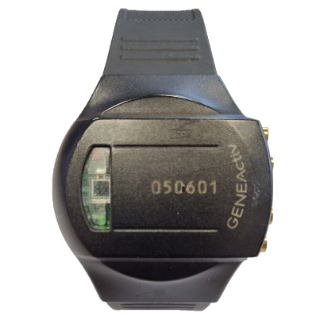
These devices measure acceleration, and average acceleration across the day giving us a good indication of the general physical activity level of the wearer. We can also get information about how that activity happens. For example, someone who engages in sustained activity at close to their average level throughout the day might show a similar average acceleration to a person who concentrates their activity into a few short bouts of vigorous activity with periods of rest between. Because of the detailed second by second data we get from our accelerometers, we can also distinguish these different patterns of activity.
However, there is more to activity monitoring than just measuring activity. Studies have shown that prolonged periods of sitting are detrimental to health [1], and this is not mitigated by vigorous exercise at other times – so you can take a lot of exercise, but still sit for longer than is good for you.
Naturally therefore, we wanted to know if we can also collect meaningful data on sedentary behaviour from our accelerometers. We know that they can tell how much the wearer is moving, but can they really tell the difference between sitting and standing still? We set about finding out!
The first step was to look into how people had tried to do this before. One method is to look at the orientation of the device [2]. This is possible because the accelerometer detects the force of gravity and so can detect the difference between the three orientations shown.
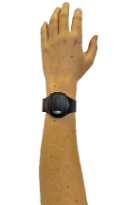
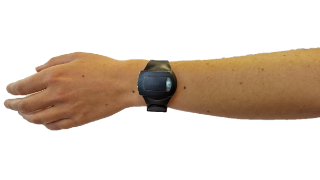
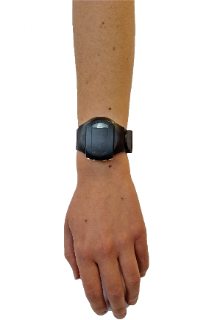
A B C
This method assumes that when the accelerometer is oriented in a position close to C, the arm is hanging with the hand much lower than the elbow, and hence the wearer is classified as standing; but if it is oriented closer to A or B, then the hand is on a similar level to the elbow (B), or higher than the elbow (A), and the wearer is assumed to be sitting or lying - unless the accelerometer is also detecting movement, in which case it assumes the wearer is not sedentary.
The second step was then to wear the accelerometer myself for 24 hours and keep a detailed log of when I was sitting, when I was sleeping in bed, and when I was upright. This proved to be very illuminating. Below are two graphs showing two one-hour periods during the day. Plot 1 shows the hour between 21:30. and 22:30.

Plot 1
The pink line shows my diary and is high when I recorded that I was upright. The blue line shows the accelerometer data and is also high when it judges me to be upright. My records say that I was upright between 21:54 and 22:05 and the accelerometer has picked this up in a series of bursts. The accelerometer has very accurately recorded when I was sedentary.
Plot 2 shows the period between 11:00 and 12:00 in the morning.

Plot 2
Here the accelerometer and diary disagree much more, with the accelerometer detecting much more upright time than was genuinely the case; but not detecting the upright period between 11:38 and 11:41 very accurately. During this period I was mostly sitting at my desk working at the computer. I was probably moving my arms quite a lot, which would have overridden the orientation data indicating sedentariness.
The jury is still out therefore on whether wrist worn accelerometers, which give us so much useful information about the duration and intensity of activity, can capture sedentary behaviour as accurately; and some researchers use different devices such as inclinometers, or positioning on the trunk or thigh, to obviate this issue. These approaches are not without their own challenges however, especially when devices are worn continuously for several days. There is still work to be done to understand how better to detect periods of sitting by, for example, changing the range of angles deemed to represent the upright stance, and/or the level of motion required to override the orientation data. This is turning into a very interesting challenge however, which we hope will lead to us getting even more useful data from MASS Lifecourse.
- Hamilton, M.T., et al., Too Little Exercise and Too Much Sitting: Inactivity Physiology and the Need for New Recommendations on Sedentary Behavior. Curr Cardiovasc Risk Rep, 2008. 2(4): p. 292-298.
- Rowlands, A.V., et al., Assessing sedentary behavior with the GENEActiv: introducing the sedentary sphere. Med Sci Sports Exerc, 2014. 46(6): p. 1235-47.
Last modified: Fri, 15 Nov 2024 15:04:55 GMT






